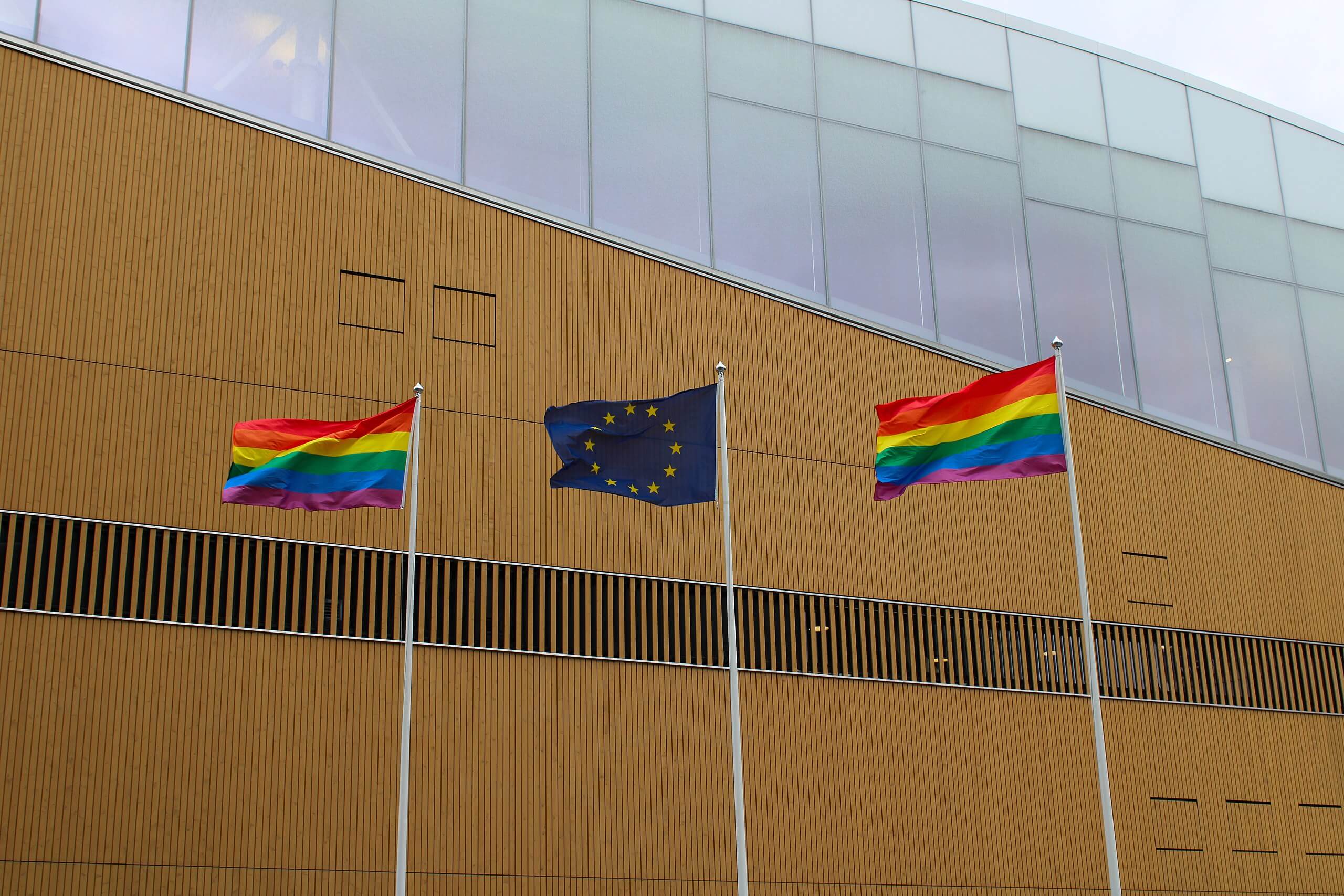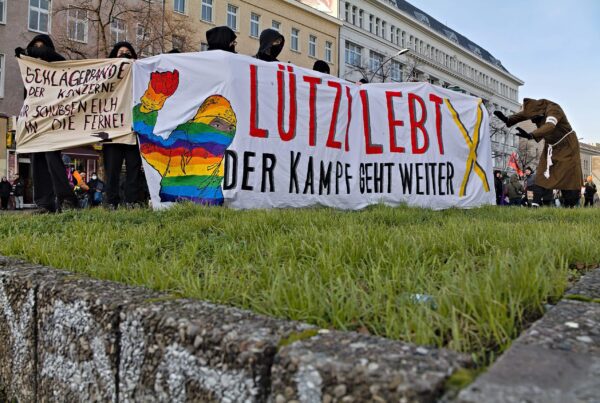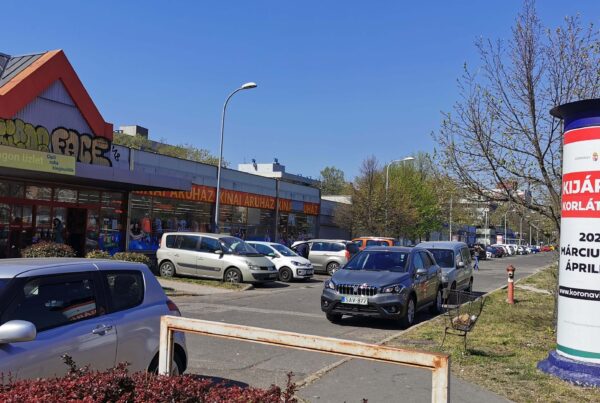The concept of culture wars is at once appealing and unsatisfactory on many counts. On the one hand, there is no denying that an increasing and antagonistic logic of us vs. them (or them vs. them, if you prefer) pervades political debate—especially when it comes to “controversial” and emotionally invested topics such as LGBT+ rights. Thus, any attempt to provide a critical commentary on the deployment of the concept inevitably runs into empirical stumbling blocks: How can one deny that the political climate concerning LGBT+ rights is principally characterized by two opposed camps?
In that sense, I echo Rico Isaacs in his piece in this series, in which he argues that culture wars, as a concept, make almost instinctive sense and are impossible to overlook. Not least, it is difficult to circumvent culture wars as a political phenomenon, inasmuch as they are a rhetorical style that seems to be sponsored by “progressives” and “conservatives” alike—so much so that one wonders whether such antagonistic deadlocks are the envisioned endpoint of the democratic conversation. On the other hand, and still in line with Isaacs’ argument, I find the concept of culture wars to have little analytical or normative purchase—at least if deployed on its own. The concept not only simplifies and distorts reality, but also seems to end up reproducing—rather than seeking to interrogate and transform—those hostile relations that are so derogatory to a healthy democratic society.
In what follows, I will briefly introduce the approach from which I draw inspiration, which stems from the philosopher Jacques Derrida and the political theorist Ernesto Laclau, with further development by Lasse Thomassen, before providing a few examples of its merits.
The Who’s Who and Everything in Between
In public debate, pop culture, and academic research alike, a certain fetishization of Self/Other relations is apparent. In public debate and pop culture, heroes and victims are opposed to villains and scapegoats. In some strands of—especially poststructuralist—research, the analysis of political discourses often aims to uncover (potentially problematic) us/them relations. On the one hand, this kind of research most often seeks to highlight that such binaries are both normatively and empirically questionable, thereby pointing to something beyond such simplified representations of reality. On the other hand, one should be careful not to overemphasize the uncovering of us/them discursive constructions, letting antagonism and difference be the only reported result of the analysis. Thus, while most people would agree that such binaries are simplified representations of reality, they nevertheless bear a strong degree of public and scholarly investment.
A very simple example will illustrate the shortcomings of such binaries: Imagine that you enter a classroom and ask the students to split up into two groups according to whether they are, say, upper-class or lower-class, patriot or foreigner, heterosexual or homosexual, military supporter or pacifist. What you would most likely see is an uncertainty among a small group of students about where to place themselves. These students might argue that they do not belong to either, or that it would be to simplify their self-perception and identity to choose one of the groups. What would happen to those who could or would not place themselves in one of the two groups? You would either have to force them to choose a category or they would have to disengage from the exercise in order for you to end up with a perfectly dualistic grouping. In effect, their exclusion is what makes the exercise possible in the first place as well as what makes it fail in the end.
If we take this to the realm of politics, it is not unusual to see political discourses drawing such distinctions between the “good” and the “bad,” “us” and “them.” But these oppositional pairs, also called antagonisms, are never able to neatly sort and represent everyone. Such a representation of reality will ultimately fail by producing remainders. What happens in such discourses? Those people or phenomena that cannot effectively be subsumed under the heading of one of the antagonistic poles will become what in Poststructuralist Discourse Theory is termed heterogenous. Heterogeneity refers to what escapes the logic of inside/outside, us/them—that is, “an excess escaping the attempt to discursively objectify the boundaries of identities” (p. 43).
I believe that a research program that seeks to account for so-called culture wars concerning such issues as LGBT+ rights as well as all those examples of heterogeneity that seem to call simple us-vs.-them depictions of reality into question holds immense value if we are to properly understand, transform, and reimagine the undeniable antagonisms that characterize democratic debate.
Homonationalism, Queer Ideology, and the Case of Denmark
In a recent article published in Redescriptions: Political Thought, Conceptual History and Feminist Theory entitled “Between Two Ills,” I sought to uncover the way in which homonationalism, as theorized by Jasbir Puar, might, following the assumptions found in the political theory of Chantal Mouffe, come to fuel negative, even hostile, attitudes toward the feminist and LGBT+ movements. In short, when LGBT+-friendly attitudes are made an emblematic symbol of the Danish nation and national belonging as such, a demarcation between the pro-LGBT+ citizen and the anti-LGBT+ citizen is established. This us/them relation, this moment of exclusion of those who do not unconditionally support or identify with the pro-LGBT+ image of the nation, can potentially become a breeding ground for negative sentiments toward LGBT+ organizations, which are seen to represent the interests of sexual and gender minorities.
In 2018, seven Evangelical Christian organizations pushed back against the then center-right government in Denmark for propagating so-called “queer ideology” through its recently published LGBTI Action Plan. The “queer ideology” was, more or less, given the same features as we are seeing political leaders and anti-gender movements around the world ascribe to the infamous “gender ideology.” However, a few weeks later, during Copenhagen Pride Week, the debate took a new turn. The former Prime Minister of Denmark, Lars Løkke Rasmussen, gave a speech that was interpreted by the Christian organizations to exclude them from the image of a “proper Dane”:
For me, Copenhagen Pride is a manifestation. For freedom, liberal-mindedness, and community. A message to every corner of Denmark. Every part of Europe. Every area of the world. That […] we here in this country object—as in, completely—to forces that want the stock-conservative view of human nature of the past. That we in our society—our country—stand together for the right to be who one is.
In the LGBTI Action Plan, as well as during Copenhagen Pride Week, the former government made it clear that sexual and gender minorities, especially those with an ethnic minority background, were the ones suffering from such a “stock-conservative view of human nature of the past.” Nevertheless, it was the Christian organizations who reacted. They decried their exclusion from the demos and ascribed it to the effects of the “queer ideology” that they believed originated with the feminist and LGBT+ organizations. An example of such a critique is provided by Hans Ole Bækgaard, the chairman of one of the organizations, Indre Mission:
When the Prime Minister in connection with Copenhagen Pride says that in this country one objects to forces that want the stock-conservative view of human nature of the past, then I must assume that the Prime Minister refers to a person such as me. That I have a stock-conservative view of human nature when I want to maintain that there is something called man and woman. […] It is problematic that I must experience not being able to count myself as a real Dane and someone who does not want our society because I do not agree with what the Prime Minister was talking about.
Through the analysis performed in the aforementioned article, I showed that the ensuing public debate indeed supported the theoretical thesis that homonationalism holds the potential to fuel negative attitudes toward the LGBT+ movement. This is a critique not of pro-LGBT+ politics as such, but of how the latter can have adverse effects when inscribed within an exclusionary, nationalist formula. The theory of homonationalism is already an important critique of how the pro-LGBT+ nation is constructed by othering the (allegedly) homo- and transphobic attitudes of racial, cultural, and religious others, most often Muslims. In the shimmering light of “gay and trans rights!,” we must interrogate those instances when pro-LGBT+ politics parading as a progressive consensus are used to condemn, exclude, ridicule, draw borders, legitimize war, etc. This only reproduces a culture war rationality based on (racialized) stereotypes.
More to the point, when it comes to the aims of “Between Two Ills,” pro-LGBT+ politics can end up having counterproductive effects when the image of LGBT+ rights becomes associated with moralizing, nationalistic or otherwise exclusionary political practices. This is a call to remain attentive to the implications for those we mean to protect when pro-LGBT+ politics joins forces with exclusionary forms of nationalism, security, neoliberalism, capitalism or Eurocentrism.
This is not only a normative matter, but also has important implications for the analytical value of the culture wars concept. One implication that follows from such an analysis is that the simple us-vs.-them, progressive-vs.-conservative, pro-vs.-anti-LGBT+ distinction becomes troubled. What is perceived by many, and to a large extent rightly so, as a positive instance of the central political power embracing sexual and gender minorities ends up producing counter-productive effects that cannot be properly captured within a culture wars framework.
This is not a matter of categorizing politicians—using a homonationalist or otherwise exclusionary and moralistic discourse—as “the bad guys” instead of the “good guys,” but of realizing that the potentially negative effects of championing LGBT+ rights in such a register cannot be characterized unequivocally as “progressive.” Thus, I would argue that the effects of such an (unhappy) marriage of pro-LGBT+ stances and nationalist rhetoric may be an example of a heterogenous excess that eludes the former government’s attempt to objectify the boundaries of its identity as pro-LGBT+, to paraphrase Thomassen.
Rather than being a somewhat harmless instance of anti-gender opposition by a marginal Christian minority in Denmark, one could argue that it made “the general public more conscious of certain concepts and of their alleged dangers, serving as the scaffolding of a larger movement” (p. 125). Even more importantly, there has since been an increase in politicians and political parties on the right adopting the same anti-gender rhetorical strategy to thwart attempts to deepen and extend rights to sexual and gender minorities in Denmark, as well as to challenge the legitimacy of gender, anti-racist, migration, and queer research(ers). The importance of attending to the heterogenous excess of homonationalism, or pro-LGBT+ consensuses more generally, thus should not be understated. While there is little doubt that the public debate principally takes the form of an us-vs-them relationship, thereby supporting the “culture war” characterization, an analysis of the emergence of the Christian organizations’ contestation and the effects of homonationalist discourse for the LGBT+ organizations, as well as the degree to which LGBT+ people themselves identify with a homonationalist agenda, paint another picture.
An EU Culture War over LGBT+ Rights?
This picture is not devoid of anything resembling a culture war. I am, therefore, not disagreeing with the value of analyzing how public debate or entire societies are conditioned by an us-vs.-them binary. The problem arises if we stop the analysis there. Something or someone escapes this simplistic inside/outside logic—what I have referred to as heterogeneity. And the values we sometimes inadvertently ascribe to one or the other camp (progressive, conservative, right, wrong, etc.) are never as simple a story as they might appear.
I would contend that we are currently witnessing a similarly problematic perception of the political struggle taking place in the European Union concerning LGBT+ rights and freedoms. It is well established in the literature that the European Union has positioned itself as a pro-LGBT+ Union. Similarly to what we saw in the above example of Danish homonationalism, the EU promotes and enforces an EU identity informed by positive attitudes toward LGBT+ equality—against various concrete and imagined Others (see, for example, Eigenmann 2022; Kulpa 2014; Paternotte 2019; Slootmaeckers 2020; Thiel 2020).
In recent years, the image of an LGBT+-friendly Union has been challenged by opposition from political leaders in Hungary and Poland as well as growing anti-gender sentiments, which view the promotion of various sexual, women’s, and LGBT+ rights as representing an authoritarian and ideological threat to society. Critics have singled out “Brussels” as the author of such a gender ideology through gender and LGBT+ mainstreaming. This has met with extensive critique from the European Commission, most recently in the Commission’s LGBTIQ Equality Strategy 2020-2025 and in President of the Commission Ursula von der Leyen’s State of the European Union Address in 2020. Further, in June 2021, the Commission launched infringement procedures against Hungary and Poland for violations of the fundamental rights of LGBT+ people, and in July 2022, the Commission referred Hungary to the EU’s Court of Justice over the Hungarian Children Protection Act.
One might argue that this tense political situation could be characterized as a culture war between Eastern and Western EU countries, between traditional family values and LGBT+ equality. According to this depiction, the Commission, along with MEPs and Member States, are at (culture) war with the supposedly homo- and transphobic political leaders of Central and Eastern European member states and their supporters. What is wrong, both empirically and normatively, with this depiction?
As we have already established, this dualistic representation papers over the “fissures” and contradictions. The point is neither to deny nor to support the horrific implications of scaling back freedom and equality for sexual and gender minorities. The point is that, precisely because of the importance of this issue, we should deploy an analytical framework that allows us to ask critical questions that put into perspective and are able to reveal the contradictions in the “good guy vs. bad guy” representation, such as:
- How does the “progressive” reaction by the Commission, as well as the declared pro-LGBT+ identity of the European Union, play a part in fueling negative sentiments toward sexual and gender minorities and the EU itself? That is, in what ways does a Homo-European discourse draw internal and external symbolic borders, boundaries, and distinctions—and what are the implications thereof? I am personally far from convinced that moralizing about the proper European values is the best way to circumvent further alienation and negative sentiments toward sexual and gender minorities. On the contrary, it could end up fanning the anti-Brussels, anti-LGBT+ flames, which politicians and movements can capitalize upon and instrumentalize.
- To what extent are the pro-LGBT+ camp of EU institutions, member states, and MEPs really embracing pro-LGBT+ equality in their own countries and agendas—especially when compelled to balance such concerns with other interests? That is, do the “progressive” countries invest the same energy in ensuring better living conditions, rights, and equality for sexual and gender minorities “at home” as they do in making sure that the EU “dark horses” do?
- To what extent does the pro-LGBT+ camp in the European Union and its policies represent the LGBT+ movement, when we take into account that sexual and gender minorities embody many lines of stratification and political convictions? As has been highlighted by feminist researchers, among others, the EU can be characterized as a neoliberal project, which affects how ideals such as rights, equality, tolerance, and inclusion are understood and translated into policy. One could question whether all sexual and gender minorities identify with a pro-LGBT+ discourse that stresses the self-ownership of the individual for the purposes of being fit for the market.
- Finally, we should be able to ask the even more difficult question of whether some LGBT+ organizations are inadvertently complicit in supporting a potentially problematic Homo-European discourse—and in what ways they need to buy into such a discourse in order to be heard in political circles.
In other words, is the “culture war” representation true to life?
Without presupposing the answers to all these questions or that they would all put the EU in a bad light, I contend that such questions will not be answered satisfactorily by attending to culture wars without simultaneously paying attention to the heterogeneity that troubles the otherwise homogenous picture of us vs. them. What we know as culture wars are, in that sense, a representation of reality, which it is important to take into account but which does not tell the full story. It is at the same time present and a distortion that only can be accounted for when taking heterogeneity into consideration. Most importantly, if we do not attend to what escapes the simplified logic of culture wars, we are left with few tools to normatively envision how such culture wars might be transformed down the road.
Photo: “Oodi Library European Union and Pride Flags 2020-09-12” by Josefiina Alanen licensed under CC BY 4.0.







